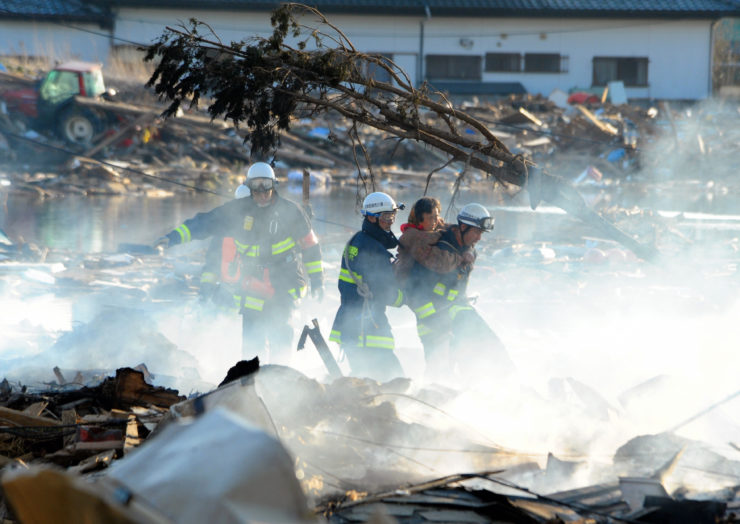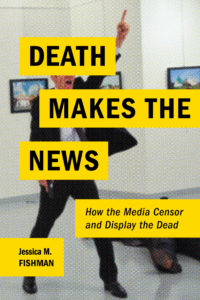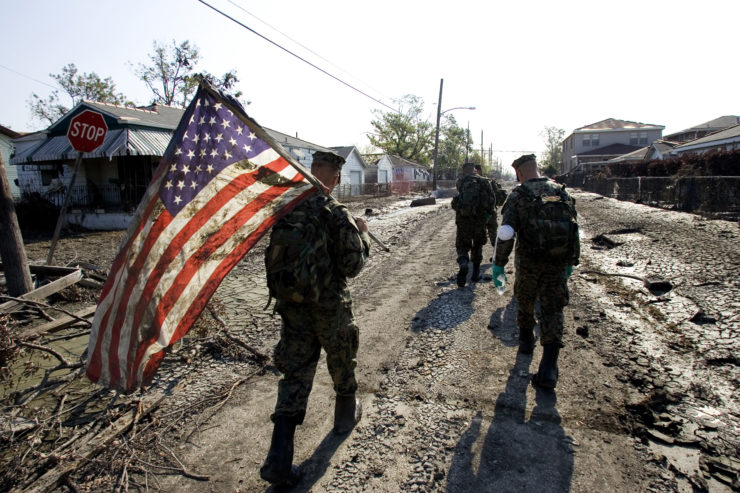
Firefighters rescue a woman from smoking ruble in Natori, Miyagi a day after the 2011 earthquake and subsequent tsunami struck Japan. While photo coverage of American tragedies often depicts people acting heroically, the same is rarely true in U.S. coverage of foreign crises
In “Death Makes the News: How the Media Censor and Display the Dead,” being published November 21 by NYU Press, social scientist Jessica M. Fishman probes a double standard in the U.S. media regarding images of death in the U.S. versus elsewhere.
Her research included an examination of 30 years of photojournalism and interviews with more than two dozen editors and photojournalists working at the Los Angeles Times, The New York Post, The New York Times, the Philadelphia Daily News, The Philadelphia Inquirer, The San Diego Union-Tribune, ABC News, NBC News, CNN, and the Associated Press. Fishman’s examination found that images of corpses in other countries are much more likely to be published than images of dead Americans. Whereas the magnitude of a tragedy in a foreign nation has a direct bearing on the likelihood that an image of death will be published in American newspapers, the reverse is true for tragedies in the U.S. She writes, “When news cameras document foreign tragedy, it is argued that these kinds of ‘unsettling’ images should be shown precisely because they harness the horror, but pictures documenting American bodies are actually condemned for being disturbing.”
Fishman, who holds a joint appointment at the University of Pennsylvania’s Perelman School of Medicine and Annenberg School for Communication, hopes her work will foster discussion about why U.S. editors decide as they do. An excerpt:
Although news editors and audiences tend to have faith that there is value in bearing witness to foreign tragedy, fantasizing about the potential benefits of seeing these images, we do not imagine that the domestic depictions could have positive effects. Instead, we expect that pictures, which happen to reveal domestic deaths, will cause great harm and should not be published.

"Death Makes the News: How the Media Censor and Display the Dead" by Jessica M. Fishman (NYU Press)
When reporting on Hurricane Katrina, photojournalism, in general, was treasured. However, the pictures of the dead were specifically dismissed. Similarly, in news coverage of the September 11th terrorist attacks, photojournalism was generally given an esteemed position, elevated above the role of words. But the images of the fatalities were again dismissed as un-newsworthy, even though the words reporting on death were prioritized. When death is the subject at hand, the value we otherwise place on documentary pictures is often inverted.
U.S. news media regard Americans’ demise as the most newsworthy. Several studies of U.S. news have reached this conclusion after finding that, when Americans die, the news media are more likely to report on the event and give the story more prominence.
But these conclusions were reached by studying the use of words, and measured things like the frequency and size of headlines and the length of copy. The pictures have not been a focus. How we literally view the world—what we do and do not see—may also be dictated by nationalistic impulses. Quite possibly, the geopolitical chauvinism shaping the use of words also influences the use of pictures. If the same editorial bias influences how editors select pictures, the news images would be less likely to focus on the foreign than the domestic death. But does photojournalism follow the same formula?
To address this question, we examined three decades of news coverage in four large U.S. newspapers to track how often postmortem pictures reveal American bodies.
Nationality does powerfully influence which images are judged newsworthy.
But in contrast to the words that focus on American victims, the pictures mostly refuse to focus on them. Among news coverage of current events, only 30 percent of photographs documenting a death depict an American victim. Even though most news stories report on American tragedy, 70 percent of the pictures documenting fatalities do so by depicting another country’s loss of life. In a heavily lopsided way, editors judge pictures of dead foreigners to be most newsworthy.
The pattern is well represented by the Washington Post’s “Year in Review.” For example, at the end of 2013, the Washington Post included an online slide show of the “best photos of the year.” For this purpose, editors curated eighty-six “eye-catching” and “striking” images that showed several foreign corpses, but no American ones. Of course, Americans did die that year. In fact, this was the year of several very high-profile American deaths, including those of the people killed by the Boston Marathon bombing.
Every day, photo editors have to make decisions not only about which images to run but also about how to run them. They have to choose which are worth publishing large, and which should appear on the front page or home page. For this reason, we also assessed the size and placement of American and foreign corpse images. We also judged whether the corpse is cropped closely, or appears in an image’s background because the perceived distance of the subject serves as another measure of prominence. For each of these measures, our team found that the foreign corpse photograph is used more prominently than the American corpse photograph.
The foreign pictures run larger and are more likely to be placed on the front page or home page. In addition, the vast majority of photos depicting American corpses place the body in the distance, but foreign corpses are typically revealed close up or at midrange.
Just a few months prior to Hurricane Katrina, on December 26, 2004, an undersea megathrust earthquake triggered a series of devastating tsunamis along the bordering coasts of the Indian Ocean. With a magnitude between 9.1 and 9.3, it was the third-largest earthquake ever recorded on a seismograph, and over 227,800 people died, making this earthquake one of the deadliest in recorded history, as well as the deadliest tsunami in history.

U.S. media often publish images featuring symbols of America’s strength, such as this flag rescued from a flood-ravaged home in New Orleans after Hurricane Katrina, in the wake of domestic disasters—a stark contrast to the photos of corpses they frequently publish after similar foreign tragedies
Given that the hurricane and tsunami were both large-scale natural disasters occurring just a few months apart, it is useful to compare the photojournalism generated. For this purpose, we examined how large, respected newspapers covered the first two weeks. By taking a close look at the New York Times, Washington Post, Boston Globe, and Los Angeles Times, we found instructive patterns quickly emerging that again illustrate the role of nationalism.
The Boston Globe, for example, used corpses to clearly illustrate the horrors of the Indian Ocean tragedy, but not the loss of life during the domestic disaster. In fact, during the first fourteen days of Katrina coverage, the Boston Globe included no photographs of corpses or even body bags in the stories detailing the nearly two thousand deaths. Instead, the photojournalism documented survivors, emergency officials, and the newly reformed landscape. The images most suggestive of death included photographs of thoroughly concealed corpses made invisible by closed coffins. Photojournalists covering Katrina had documented American corpses, and these images were made available by wire services, but they were widely rejected by editors.
By contrast, during its first fourteen days of tsunami coverage, the Boston Globe published eight photographs of corpses, in addition to four photographs of body bags.
The Washington Post included ten pictures of visible corpses in just the first seven days of its tsunami coverage, but was relatively reluctant to show the Americans killed by Katrina. Even though corpse photographs were much more likely to appear in the coverage of the tsunami, the coverage of the domestic tragedy included more pictures.
Tragedies enlarge the role of photojournalism—increasing the number of photographs that run and the prominence they are given—and this is especially true when the threat is domestic. But during American crises, photojournalism’s role grows, as the value of certain pictures diminishes. When covering catastrophe abroad, a much wider range of images is permitted.
In times of trouble, when a nation is responding to a crisis, such as a large terrorist attack or a major natural disaster, the news acts as much more than just a vehicle for conveying facts. As many social scientists have observed, the news favors storytelling, promoting narratives that help articulate a nation’s identity. They tell stories reinforcing the group’s ideal sense of who they are collectively.
With a narrative arc that reflects a sense of progress, restoration, and redemption, the storytelling by American news media during a crisis is saturated with the “language of civic renewal.” Reporters queue this narrative when announcing the presence of a major American tragedy that, in their common refrain, has “shocked” the nation. Bystanders, commentators, and reporters themselves share their astonishment at the magnitude of the death and destruction. Eventually, the reporting turns to talk of a nation united in “mourning.” And ultimately, the narrative portrays a nation ready to emerge stronger. Meanwhile, photojournalism offers its brand of affirmation. In coverage of the terrorist attacks of September 11, 2001, the same types of images fueled photojournalism. The cameras again captured many homemade signs declaring, “America will overcome.” Journalists, like those in Time magazine, elaborated on such sentiments: “So much that was precious has died, but as though in a kind of eternal promise, something new has been born. We are seeing it in our nation and sensing it in ourselves, a new faith in our oldest values, a rendezvous with grace.” Newsweek’s headline boldly announced, “We Shall Overcome.” The photojournalistic coverage of 9/11 also resembled that of the Oklahoma City bombing as cameras documented the massive wreckage. There was no shortage of pictures recording the damage to the World Trade Centers. In addition, the cameras zoomed in on first responders, especially the firefighters, who were heralded as heroes. The cameras also locked on ordinary citizens supporting one another in tearful embraces.
In news coverage of major international tragedies, the corpse is shown because it is considered part of an editor’s noble pursuit to reveal the magnitude of loss. There are few words or pictures communicating about a triumphant national destiny. In contrast to the domestic coverage that revels in the heroes, whether in the form of teachers (like those responding to the Newtown massacre), firefighters (as was the case with the 9/11 Twin Tower coverage), or other first responders, news coverage of foreign crises habitually neglects the role of the hero, along with other staples of the redemptive narrative. In reporting on tragedy abroad, there is a notable absence of flags and other signs of a nation’s strength. There is also no place for talking about another country’s “great land” or a nation that “prevails”—sentiments that are commonly shared in news coverage of domestic tragedy to signal the nation’s glorious calling. In the accounting of foreign tragedies, a dire narrative unravels. In this context, certain positive attributes may seem like mostly American traits because, through words and pictures, we build national narratives distinguishing ourselves from others.



